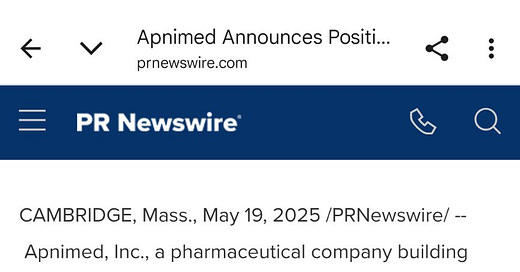Another entry for the repurposing files
Overactive bladder + ADHD therapeutics for obstructive sleep apnea
Interesting news coming out of my neck of the woods. Apnimed is a small biotech out of Cambridge, funded by local VCs, who’ve combined aroxybutynin and atomoxetine and had seemingly good results in a phase 3 trial of obstructive sleep apnea (i.e. snoring that wakes you up).
Aroxybutynin is the enantiomeric form of oxybutynin, which is an anti-muscarinic used for overactive bladder. Enantiomers, which I’ve written about before in the context of omeprazole and esomeprazole, are nominally chemically different forms of molecules that are really just clever ways to create patents on existing drugs. Anti-muscarinic drugs have a variety of effects, such as being half of a different, repurposed combination that I wrote about, xanomeline/trospium for schizophrenia.
Atomoxetine is a selective norepinephrine uptake inhibitor (SNRI) used for ADHD treatment, which you might know better as Strattera. The two of these might seem like a strange combination for sleep apnea, but the argument seems to be that sleep apnea is caused by relaxation of one of the tongue muscles, the genioglossus, during non-REM sleep, and by relaxation of the pharynx, the throat muscle, during REM sleep. This tongue muscle can be tightened by activation of the adrenergic drive by an SNRI stimulant, and the pharynx can be tightened by application of an anti-muscarinic. Also, perhaps more relevantly, stimulants tend to wake you up, and antimuscarinics, like Benadryl, tend to make you sleepy.
Like many ideas in the repurposing space, this one has a long, bumpy history. Atomoxetine was tested for sleep apnea in the 2000s by Eli Lilly, the original patent holder. It worked, but it also tended to wake people up, which was counterproductive. 10 years later, a sleep scientist at Brigham and Women’s, Luigi Taranto-Montemurro, combined oxybutynin with atomoxetine, drawing from some recent rat studies showing the connection between the genioglossus and muscarinic activation1.
He and his postdoc advisor, Andrew Wellman, spun this out with the help of a veteran pharma guy, Larry Miller, who apparently has 9 pharma startups under his belt, according to his profile on the Apnimed website. Dr. Miller then helped T-M and Wellman pull the veteran move of replacing oxybutynin with aroxybutynin, supposedly to reduce the dose of the antimuscarinic and side effects but really to shore up the patent, as oxybutynin is a generic but aroxybutynin is not2.
With Larry Miller’s network, reputation, and experience, Apnimed, as the new company was now known, zoomed through the pharma development process, by pharma standards, at least. I mean, they started in 2018, and it’s now 2025, with a phase 3 done and $142 million raised. They’ll probably be ready to sell this year. That’s pretty fast.
What does this mean for sleep apnea? Eh, only so much. The combo works, but it’s worse than a CPAP machine and about as good as a dental appliance. The side effect profile isn’t nothing, given a 12% discontinuation rate over 4 weeks and the association of longterm antimuscarinic use with dementia. The only sleep apnea sufferers who will use this treatment are people who have failed out of other treatments (i.e. CPAP, weight loss, and dental appliance).
But this does mean another success for combos and drug repurposing. Huzzah!
Yeah, this seems backwards to me, too. The original papers claim that muscarinic activation is connected to the genioglossus, and later papers claim that, no, muscarinic activation is about the pharynx, and adrenergic activation is connected to the genioglossus. My take is that there aren’t clear demarcations between which pathway relates to which muscle, and the mechanisms cited are not nearly as clear as they’re pretending.
Side effects with aroxybutynin: 24% dry mouth. Side effects with oxybutynin: 35% dry mouth. Statistical difference? Questionable at best.




Any sleep architecture shifts?